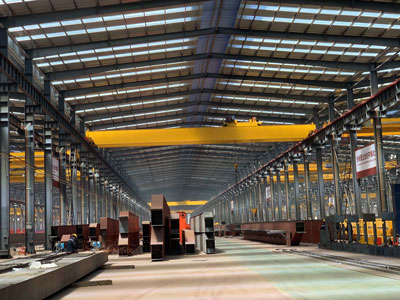Overhead crane is a kind of lifting equipment, widely used in industrial and mining enterprises, the iron, and steel chemical industry, railway traffic, port terminals logistics turnover, and other departments and places. Advantages and features of the bridge cranes include:
Overhead cranes can move to places that other equipment cannot reach. Have you ever encountered a situation where the path of a forklift truck was blocked, and you had to mobilize manpower to clear the aisle? The overhead crane can easily bypass obstacles. Suppose an independently operated push button station (which is located on its own track and therefore can be controlled from anywhere on the bridge) or wireless remote control is used as a control method. In that case, the operator can navigate around obstacles and control the crane on its own. You can arrange the factory floor according to the business style without worrying too much about the obstacles on the factory floor.
Your floor space is cleared because your crane’s bracket is not on the road. More often than not, your crane supplier can come up with a stand-alone column design that can be aligned with your building columns or along a wall. You can choose a crane that is mounted on the ceiling (usually on new buildings designed for loads), or you can support the crane from the floor. Sometimes the two can be used in combination, with some support coming from the floor and some from the ceiling of the building.
Crane operators can put themselves in the best position to move cargo safely. Forklifts create blind spots, which are inherent in the structure around the operator. Forklifts are prone to rollover (this is the leading cause of forklift deaths), pedestrians can be hit by forklifts, drivers or employees can be killed by forklifts, or drivers can fall off forklifts. Bridge cranes can also be equipped with anti-collision devices to prevent them from colliding with cranes in the same harbor or end.
The bridge crane has a wide range of uses in the accessories below the hook. The available types are unlimited. Accessories under the hooks include booms, C-hooks, scales, custom-designed lifting tools, manipulators and vacuum lifts, to name a few. Many cranes have several different tools under the hook that can be replaced according to the needs of the specific job.

Your entire plant can be covered, with no covered dead corners. Even if there is no clear path or aisle, the overhead crane can travel directly on the load. This gives you maximum flexibility in setting up your plant design.
When handling heavier loads, you can keep your plant personnel away from the load. A forklift requires your operator to be close to the load. With the bridge crane, the operator can assemble the load and then move away from danger while using the above-mentioned radio or independently driven push button station.
Overhead cranes are very cheap to operate. From completely manual systems with no energy requirements, to very economical three-phase systems. There is no need to charge the battery or inflate the tank. Bridge crane ready to work!
A recent trend is to help workers in their work units. Ergonomic small work unit bridge cranes have replaced workers moving products manually and allow them to pick up products with lift assistance. A typical 50-pound load can now be picked up with a crane, and the operator sees only half a pound of push pull at the hook. When workstation cranes are equipped with custom lifting tools, work can be done with higher productivity and less product damage.
Whether handling larger loads or reducing the burden on workers, they are more productive with a bridge crane. In high-cycle applications with light loads, workstation cranes are easy to get a return on investment in a very short period of time.
In short, overhead cranes play an indispensable role in a number of industries such as manufacturing, construction, and warehousing. They are known for their ability to lift heavy objects and move them easily, offering significant benefits in terms of time and productivity.